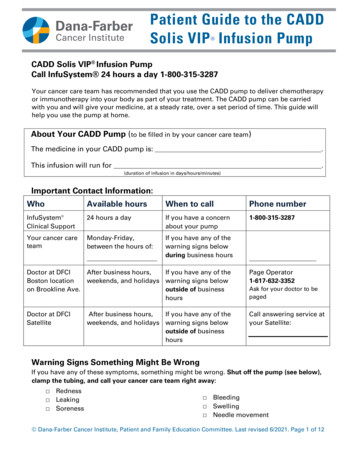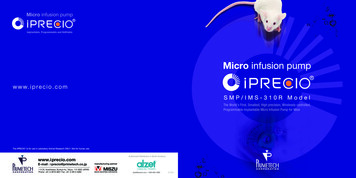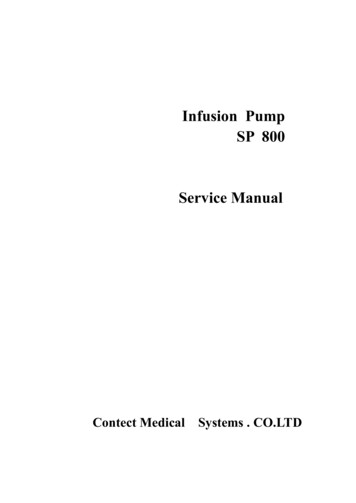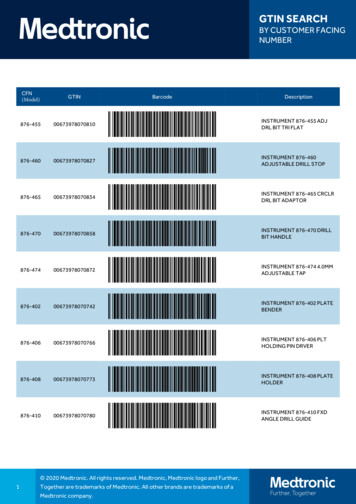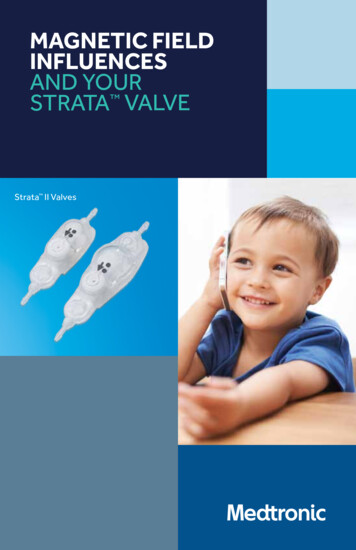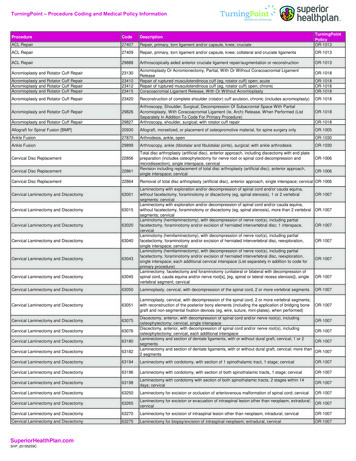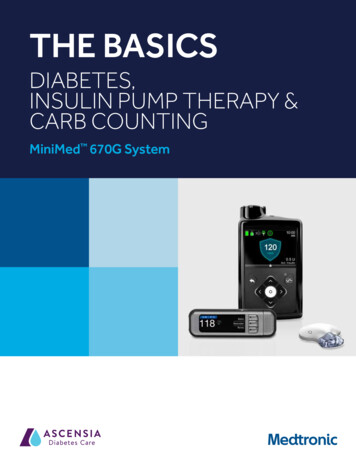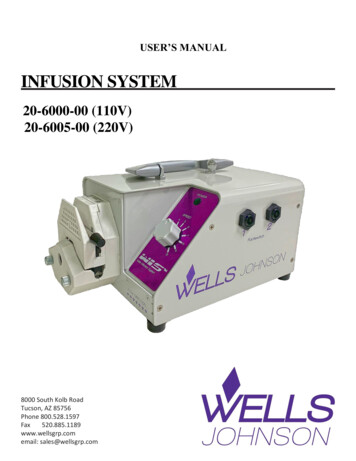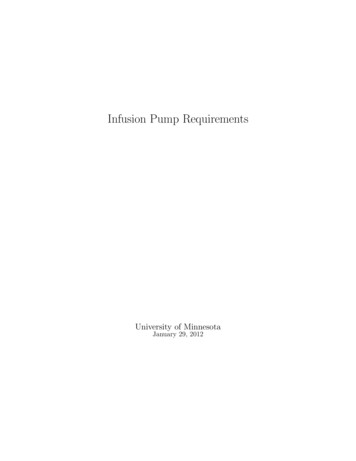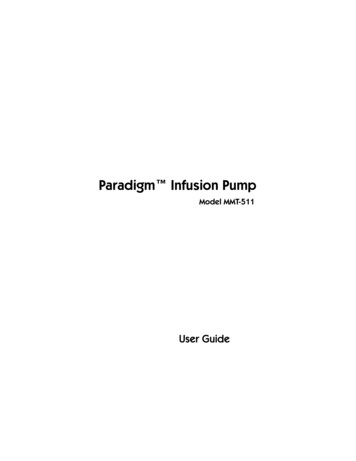
Transcription
Paradigm Infusion PumpModel MMT-511User Guide
2005, Medtronic MiniMed. All rights reserved.This product is covered by U.S. Patent Nos. 6,551,276 and 6,554,798. Other U.S.and/or foreign patents may be pending.Bolus Wizard is a registered trademark of Medtronic MiniMed.Dual Wave is a trademark of Medtronic MiniMed.Easy Bolus is a trademark of Medtronic MiniMed.Square Wave is a trademark of Medtronic MiniMed.BD Logic is a trademark of Becton, Dickinson and CompanyEnergizer is a registered trademark of Eveready Battery Company.Glucagon Emergency Kit is a registered trademark of Eli Lilly and Company.Paradigm is a registered trademark of Medtronic MiniMed.Paradigm Link is a trademark of Medtronic MiniMed.The Link is a trademark of Becton, Dickinson and Company (Canada only)Quick-serter is a registered trademark of Medtronic MiniMed.Quick-set is a registered trademark of Medtronic MiniMed.Silhouette is a registered trademark of Medtronic MiniMed.Sof-set is a registered trademark of Medtronic MiniMedU.S., international, and foreign patent applications are pending.D9195890-015 040705
Important Safety Information Regarding YourParadigm Insulin Infusion Pump (includes all models)Avoid Immersing Your Pump In WaterAlthough it is unlikely that water damage will occur if your pump is splashedor briefly dunked, you should avoid immersing your Paradigm infusion pumpin water. To swim or participate in other water activities, always disconnectfrom your Paradigm pump and reconnect after water play.If you inadvertently submerge your pump in water, dry the pump quicklyusing a soft, clean towel and verify that it is working properly by selecting“self test” from the pump’s Utilities Menu. If you believe that water hasentered your pump or you observe any other possible pump malfunction,please check your blood glucose, treat high blood glucose (if necessary) withan injection and contact our 24-Hour Help Line at 1-800-MINIMED(1-800-646-4633) for further assistance. Symptoms of high blood glucoseinclude fatigue, excessive thirst and nausea. You should always contact yourhealthcare professional if you experience excessively high or low bloodglucose levels, or if you have any questions about your care.Electrostatic DischargeAlthough your Paradigm pump is designed to be unaffected by typical levelsof electrostatic discharge (ESD), very high levels of ESD can result in a resetof the pump’s software with an associated pump error alarm. In most cases,exposure to high levels of ESD will trigger the pump’s E-13 alarm although,under certain circumstances, high level ESD exposure can cause E-44, BolusStopped or Max Delivery alarms. High levels of ESD are more likely insituations where the relative humidity is very low, such as inside a heatedbuilding during the winter in areas where it is cold outside.If your pump experiences an E-13 or other error alarm, press the “ESC” and“ACT” buttons to clear the alarm. If you are unable to clear the alarm bypressing “ESC” and “ACT”, you may need to remove and replace the pump’sbattery to clear the alarm. After clearing the alarm, you should always verifythat your pump is set to the correct date and time and that all other settings(basal rate, max basal and bolus limits, etc.) are programmed to the desiredvalues, since the software reset could erase your previously programmedsettings. Please see the Alarms and Alerts section of this User Guide formore details regarding what to do if your pump displays an error alarm orother alert message.Please contact our 24-Hour Help Line at 1-800-MINIMED (1-800-646-4633)to report any error alarms or other problems that occur with your pump.
Table of Contents Chapter 1Introduction . . . . . . . . . . . . . . . . . . . . . . . . . . . 1For your records . . . . . . . . . . . . . . . . . . . . . . . . . . . . . . 1Assistance . . . . . . . . . . . . . . . . . . . . . . . . . . . . . . . . . . . . 2Availability . . . . . . . . . . . . . . . . . . . . . . . . . . . . . . . . . . . 2Emergency kit . . . . . . . . . . . . . . . . . . . . . . . . . . . . . . .3Pump and user guide conventions . . . . . . . . . . . . . . . . 4Your pump . . . . . . . . . . . . . . . . . . . . . . . . . . . . . . . . . . . 5Installing the battery the first time. . . . . . . . . . . . . . . . 6Home screen . . . . . . . . . . . . . . . . . . . . . . . . . . . . . . . .8Modes of operation . . . . . . . . . . . . . . . . . . . . . . . . . . . .8Normal . . . . . . . . . . . . . . . . . . . . . . . . . . . . . . . . . . . 8Special . . . . . . . . . . . . . . . . . . . . . . . . . . . . . . . . . . . .8Attention . . . . . . . . . . . . . . . . . . . . . . . . . . . . . . . . . .9Pump buttons . . . . . . . . . . . . . . . . . . . . . . . . . . . . . . .10Main menu . . . . . . . . . . . . . . . . . . . . . . . . . . . . . . . . . . 12Bolus menu . . . . . . . . . . . . . . . . . . . . . . . . . . . . . . . .13Suspend . . . . . . . . . . . . . . . . . . . . . . . . . . . . . . . . . . .13Basal menu . . . . . . . . . . . . . . . . . . . . . . . . . . . . . . . . .14Prime menu . . . . . . . . . . . . . . . . . . . . . . . . . . . . . . . .14Utilities menu . . . . . . . . . . . . . . . . . . . . . . . . . . . . . . .14Initial pump settings . . . . . . . . . . . . . . . . . . . . . . . . . . 15Basal rate information . . . . . . . . . . . . . . . . . . . . . . . .16Meal boluses . . . . . . . . . . . . . . . . . . . . . . . . . . . . . . . .16Correction bolus . . . . . . . . . . . . . . . . . . . . . . . . . . . .16i
Blood glucose targets . . . . . . . . . . . . . . . . . . . . . . . . 16Chapter 2Getting Started . . . . . . . . . . . . . . . . . . . . . . . . 17Reservoir and infusion sets . . . . . . . . . . . . . . . . . . . . . 17Preparing your pump for use . . . . . . . . . . . . . . . . . . . 18Setting the time and date . . . . . . . . . . . . . . . . . . . . . 18Installing the reservoir . . . . . . . . . . . . . . . . . . . . . . . 21Removing the reservoir . . . . . . . . . . . . . . . . . . . . . . . 22Rewinding the pump . . . . . . . . . . . . . . . . . . . . . . . . . 22Verifying insulin type . . . . . . . . . . . . . . . . . . . . . . . . 23Changing insulin type . . . . . . . . . . . . . . . . . . . . . . . . 24Manual Prime . . . . . . . . . . . . . . . . . . . . . . . . . . . . . . 28Priming with fixed prime . . . . . . . . . . . . . . . . . . . . . 30Reviewing the prime history . . . . . . . . . . . . . . . . . . . 32How to wear the pump . . . . . . . . . . . . . . . . . . . . . . . . 33Chapter 3Status . . . . . . . . . . . . . . . . . . . . . . . . . . . . . . . 35Checking pump status. . . . . . . . . . . . . . . . . . . . . . . . . 35Chapter 4Bolus Menu . . . . . . . . . . . . . . . . . . . . . . . . . . . 37Delivering a normal bolus. . . . . . . . . . . . . . . . . . . . . . 39Dual/Square bolus . . . . . . . . . . . . . . . . . . . . . . . . . . . . 40Square wave bolus . . . . . . . . . . . . . . . . . . . . . . . . . . . 41Delivering a square wave bolus . . . . . . . . . . . . . . . 42Normal bolus during a square wave bolus . . . . . . 44Dual wave bolus . . . . . . . . . . . . . . . . . . . . . . . . . . . . . 46Delivering a dual wave bolus . . . . . . . . . . . . . . . . . 46Delivering an express bolus . . . . . . . . . . . . . . . . . . . . 49When square/dual wave bolus option is off . . . . . . . 49When square/dual wave bolus option is on . . . . . . . 50Maximum bolus limit (max bolus) . . . . . . . . . . . . . . . 50Setting the maximum bolus limit . . . . . . . . . . . . . . 50ii
Easy bolus . . . . . . . . . . . . . . . . . . . . . . . . . . . . . . . . . . .Setting up easy bolus . . . . . . . . . . . . . . . . . . . . . . . .Delivering an easy bolus . . . . . . . . . . . . . . . . . . . . . .Bolus history. . . . . . . . . . . . . . . . . . . . . . . . . . . . . . . . .52535556Basal menu . . . . . . . . . . . . . . . . . . . . . . . . . . . . . . . . . .What are start and stop times? . . . . . . . . . . . . . . . . .Delivering a basal . . . . . . . . . . . . . . . . . . . . . . . . . . .Maximum basal rate (max basal) . . . . . . . . . . . . . . . . .Setting max basal rate . . . . . . . . . . . . . . . . . . . . . . .Temporary basal rate (temp) . . . . . . . . . . . . . . . . . . . .How does it work? . . . . . . . . . . . . . . . . . . . . . . . . . .Delivering a temporary basal rate . . . . . . . . . . . . . .Verifying temporary basal delivery . . . . . . . . . . . . .Canceling a temporary basal rate . . . . . . . . . . . . . . .Personal basal patterns . . . . . . . . . . . . . . . . . . . . . . . .Turning on personal basal patterns . . . . . . . . . . . . .Delivering personal basal patterns . . . . . . . . . . . . . .Selecting a pattern . . . . . . . . . . . . . . . . . . . . . . . . . .Basal review . . . . . . . . . . . . . . . . . . . . . . . . . . . . . . .Standard basal rates . . . . . . . . . . . . . . . . . . . . . . .60616264646566666768697071737474Chapter 5Basal . . . . . . . . . . . . . . . . . . . . . . . . . . . . . . . . 59Chapter 6Suspend . . . . . . . . . . . . . . . . . . . . . . . . . . . . . 77Suspending the pump . . . . . . . . . . . . . . . . . . . . . . . . . 78Resuming pump delivery . . . . . . . . . . . . . . . . . . . . . . . 79iii
Chapter 7Utilities . . . . . . . . . . . . . . . . . . . . . . . . . . . . . . . 81Alarms . . . . . . . . . . . . . . . . . . . . . . . . . . . . . . . . . . . . . 81Setting the alert type. . . . . . . . . . . . . . . . . . . . . . . . . . 82Using Auto-off . . . . . . . . . . . . . . . . . . . . . . . . . . . . . . . 84Stop auto off . . . . . . . . . . . . . . . . . . . . . . . . . . . . . . . 85Reviewing the alarms . . . . . . . . . . . . . . . . . . . . . . . . . 85Daily totals . . . . . . . . . . . . . . . . . . . . . . . . . . . . . . . . . . 86Reviewing the daily totals . . . . . . . . . . . . . . . . . . . . . . 87Block . . . . . . . . . . . . . . . . . . . . . . . . . . . . . . . . . . . . . . 88Setting up block . . . . . . . . . . . . . . . . . . . . . . . . . . . . . 88Setting the time and date . . . . . . . . . . . . . . . . . . . . . . 90Language . . . . . . . . . . . . . . . . . . . . . . . . . . . . . . . . . . . 93Setting the language . . . . . . . . . . . . . . . . . . . . . . . . . . 93RF options (remote control) . . . . . . . . . . . . . . . . . . . . 94Adding an RF ID . . . . . . . . . . . . . . . . . . . . . . . . . . . . . 94Deleting an RF ID . . . . . . . . . . . . . . . . . . . . . . . . . . . . 96Reviewing the RF ID codes . . . . . . . . . . . . . . . . . . . . . 98Clear pump . . . . . . . . . . . . . . . . . . . . . . . . . . . . . . . . . 99Clearing pump . . . . . . . . . . . . . . . . . . . . . . . . . . . . . 100Selftest . . . . . . . . . . . . . . . . . . . . . . . . . . . . . . . . . . . . 103Chapter 8Remote Control . . . . . . . . . . . . . . . . . . . . . . . 107Using your remote control . . . . . . . . . . . . . . . . . . . . 108Remote control buttons . . . . . . . . . . . . . . . . . . . . . 108Waking up your pump . . . . . . . . . . . . . . . . . . . . . . . 109Deliver an easy bolus . . . . . . . . . . . . . . . . . . . . . . . . . 110Suspend/resume the pump . . . . . . . . . . . . . . . . . . . 110Installing a new remote battery . . . . . . . . . . . . . . . . 111Cleaning your remote control . . . . . . . . . . . . . . . . . 112If the remote control is dropped . . . . . . . . . . . . . . . . 112If the remote control falls in water. . . . . . . . . . . . . . 112iv
Chapter 9Troubleshooting & Care . . . . . . . . . . . . . . . . . 113Troubleshooting . . . . . . . . . . . . . . . . . . . . . . . . . . . . .My pump has a no delivery alarm . . . . . . . . . . . . .What happens if I leave the battery out too long? .What is a check settings alarm? . . . . . . . . . . . . . . .I submerged my pump in water . . . . . . . . . . . . . . .My screen appears distorted . . . . . . . . . . . . . . . . . .Pump maintenance . . . . . . . . . . . . . . . . . . . . . . . . . .Battery . . . . . . . . . . . . . . . . . . . . . . . . . . . . . . . . . .Installing a new pump battery . . . . . . . . . . . . . .Cleaning your pump. . . . . . . . . . . . . . . . . . . . . . . . . .Storing your pump . . . . . . . . . . . . . . . . . . . . . . . . . . .Precautions . . . . . . . . . . . . . . . . . . . . . . . . . . . . . . . . .Avoiding extreme temperatures . . . . . . . . . . . . . . .Avoiding dunking the pump in water . . . . . . . . . .Special circumstances . . . . . . . . . . . . . . . . . . . . . . . .If the pump is dropped . . . . . . . . . . . . . . . . . . . . . ndications . . . . . . . . . . . . . . . . . . . . . . . . . . . . . . . . .Contraindications . . . . . . . . . . . . . . . . . . . . . . . . . . . .Warnings. . . . . . . . . . . . . . . . . . . . . . . . . . . . . . . . . . .Diabetic ketoacidosis (DKA) . . . . . . . . . . . . . . . . . .Hypoglycemia . . . . . . . . . . . . . . . . . . . . . . . . . . . . .Skin infections . . . . . . . . . . . . . . . . . . . . . . . . . . . .Reservoir and infusion sets . . . . . . . . . . . . . . . . . .X-rays, MRIs and CT scans . . . . . . . . . . . . . . . . . . .General precautions . . . . . . . . . . . . . . . . . . . . . . . . . .Precautions - hypoglycemia . . . . . . . . . . . . . . . . . . . .Precautions - hyperglycemia . . . . . . . . . . . . . . . . . . .Precautions - infusion sets and sites . . . . . . . . . . . . .123123124124124124125125125127128129Chapter 10User Safety . . . . . . . . . . . . . . . . . . . . . . . . . . 123v
Adverse reactions. . . . . . . . . . . . . . . . . . . . . . . . . . . . 130Hyperglycemia and diabetic ketoacidosis (DKA) . . 130Hypoglycemia . . . . . . . . . . . . . . . . . . . . . . . . . . . . . 131Site infection/abscesses . . . . . . . . . . . . . . . . . . . . . . 131Notice. . . . . . . . . . . . . . . . . . . . . . . . . . . . . . . . . . . . . 132Insulin pump and remote control . . . . . . . . . . . . . 132Chapter 11Alarms and Alerts . . . . . . . . . . . . . . . . . . . . . 135Alarms . . . . . . . . . . . . . . . . . . . . . . . . . . . . . . . . . . . . 135E (Error) . . . . . . . . . . . . . . . . . . . . . . . . . . . . . . . . 136Off no power . . . . . . . . . . . . . . . . . . . . . . . . . . . . 136Auto off . . . . . . . . . . . . . . . . . . . . . . . . . . . . . . . . 137Empty reservoir . . . . . . . . . . . . . . . . . . . . . . . . . . 137No reservoir . . . . . . . . . . . . . . . . . . . . . . . . . . . . . 137No delivery . . . . . . . . . . . . . . . . . . . . . . . . . . . . . . 138Motor error . . . . . . . . . . . . . . . . . . . . . . . . . . . . . . 138Batt out limit . . . . . . . . . . . . . . . . . . . . . . . . . . . . 138Max delivery . . . . . . . . . . . . . . . . . . . . . . . . . . . . . 139Button error . . . . . . . . . . . . . . . . . . . . . . . . . . . . 139Check settings . . . . . . . . . . . . . . . . . . . . . . . . . . . 139Bolus stopped . . . . . . . . . . . . . . . . . . . . . . . . . . . . 140Failed batt test . . . . . . . . . . . . . . . . . . . . . . . . . . . 140Alerts . . . . . . . . . . . . . . . . . . . . . . . . . . . . . . . . . . . . . 141Low battery . . . . . . . . . . . . . . . . . . . . . . . . . . . . . 141Low reservoir . . . . . . . . . . . . . . . . . . . . . . . . . . . . 141Message in Alarm History . . . . . . . . . . . . . . . . . . . . 142vi
Chapter 12Pump Specifications . . . . . . . . . . . . . . . . . . . . 143Specifications . . . . . . . . . . . . . . . . . . . . . . . . . . . . . . .Alarms and error messages . . . . . . . . . . . . . . . . . .Backlight . . . . . . . . . . . . . . . . . . . . . . . . . . . . . . . . .Insulin delivery . . . . . . . . . . . . . . . . . . . . . . . . . . . .Block . . . . . . . . . . . . . . . . . . . . . . . . . . . . . . . . . . . .Delivery accuracy . . . . . . . . . . . . . . . . . . . . . . . . . .Displacement accuracy . . . . . . . . . . . . . . . . . . . . . .Drive motor . . . . . . . . . . . . . . . . . . . . . . . . . . . . . .Dual wave bolus . . . . . . . . . . . . . . . . . . . . . . . . . . .Easy bolus . . . . . . . . . . . . . . . . . . . . . . . . . . . . . . . .Infusion pressure . . . . . . . . . . . . . . . . . . . . . . . . . .Insulin concentration/type . . . . . . . . . . . . . . . . . . .Normal bolus . . . . . . . . . . . . . . . . . . . . . . . . . . . . .Occlusion detection . . . . . . . . . . . . . . . . . . . . . . . .Personal basal delivery patterns . . . . . . . . . . . . . . .Power supply . . . . . . . . . . . . . . . . . . . . . . . . . . . . . .Prime function . . . . . . . . . . . . . . . . . . . . . . . . . . . .Program safety checks . . . . . . . . . . . . . . . . . . . . . .Pump size . . . . . . . . . . . . . . . . . . . . . . . . . . . . . . . .Pump weight . . . . . . . . . . . . . . . . . . . . . . . . . . . . . .Remote control . . . . . . . . . . . . . . . . . . . . . . . . . . . .Reservoir . . . . . . . . . . . . . . . . . . . . . . . . . . . . . . . . .Square wave bolus . . . . . . . . . . . . . . . . . . . . . . . . .Temporary basal rate . . . . . . . . . . . . . . . . . . . . . . .Time and date display . . . . . . . . . . . . . . . . . . . . . . .Water tight . . . . . . . . . . . . . . . . . . . . . . . . . . . . . . .Factory default settings . . . . . . . . . . . . . . . . . . . . . . .Icon table . . . . . . . . . . . . . . . . . . . . . . . . . . . . . . . . . 47147147147147147148148148148149150Index . . . . . . . . . . . . . . . . . . . . . . . . . . . . . . . 153vii
viii
Chapter 1Introduction Whether you are beginning pump therapy for the first time, orupgrading from a previous model, we are pleased that you havechosen Medtronic MiniMed as your partner to help you gain better control of your diabetes. We believe that the combination ofstate-of-the-art technology and the simple, menu-driven programming of the Paradigm pump will provide many benefits.This User Guide is designed to help you use your pump; however,working with your healthcare professional is strongly recommended for your safety and to simplify your familiarity with thepump and pump therapy.For your recordsThe pump serial number is located on the back of your pump.Please enter the serial number, purchase date, and pump startdate in the table below.Serial NumberPurchase DatePump start date:1
AssistanceMedtronic MiniMed provides a 24-hour help line for assistance inthe United States. The help line is staffed with technicians who aretrained in the set-up and operation of the Paradigm pump and areable to answer pump-related questions. When calling the help-line,please have your pump and serial number available. The help-linetelephone number is also on the back of your pump.24-hour Product Help-lineif calling from inside the United States800.646.4633(800-MiniMed)if calling from outside of the UnitedStates818.576.5555Web sitewww.minimed.comAvailabilityThe Paradigm insulin pump and its components are availablethrough Medtronic MiniMed and from authorized distributors.2Chapter 1
Emergency kitKeep an emergency kit with you at all times to make sure that youalways have necessary supplies. This kit should include: Fast-acting glucose tablets Blood glucose monitoring supplies Urine ketone monitoring supplies Short acting insulin and insulin syringe with directions fromyour healthcare professional regarding how much insulin totake An extra Paradigm infusion set and Paradigm reservoir Dressing and adhesive Extra AAA Alkaline and A23 batteries (Energizerrecommended) Paradigm Quick Reference Card Glucagon Emergency KitInform a family member, co-worker, and/or friend where thisemergency kit is kept.Please refer to Chapter 10, User Safety for more information onpump safety.Introduction3
Pump and user guide conventionsThe following terms and icons are used to describe the pump inthis User Guide.“Press” means to push and release the button.“Hold” means to push and maintain pressure on the button.Flashing words or numbers on the screen indicate informationthat can be changed in the pump.Information that cannot be changed appears on the screen in characters that do not flash.“Select” means to use the arrow buttons to access a pumpfeature.Buttons and screen names are always uppercase; for example, ESCand HOME.A note is additional, helpful information.The word “CAUTION,” warns you of a potentially hazardous situation which, if not avoided, may result in minor or moderate injuryto the user or damage to the equipment.The word “WARNING,” alerts you about a situation which, if notavoided, could result in death or serious injury. It may also describepotential serious adverse reactions and safety hazards.4Chapter 1
Your pumpTake a look at your rbuttonsreservoircompartmentThe pump is smart. It remembersyour settings and stores a record ofits actions.Turn your pump on its side.Look at the reservoir compartmentwindow. This window lets you see thereservoir. You can also find theapproximate remaining reservoir volume by looking at the STATUSscreen.reservoirwindowThe reservoir compartment onlyaccepts the Paradigm reservoirs. Thereservoir and tubing connector areinserted into the compartment.Introduction5
Installing the battery the first timeThe Paradigm pump uses a AAA alkaline battery. As a safety measure, Medtronic MiniMed has designed the pump to only accept aNEW battery. The pump is very particular, if you insert a used battery, an alarm will be triggered.If your batteries have been in a cold place, (i.e., your car in thewinter), allow the battery to warm to room temperature (up to 30minutes) before inserting into the pump.CAUTION: It is highly recommended that you use an AAA alkalineEnergizer battery. Do not use a carbon zinc battery in thepump.1. Use the edge of a coinand unscrew the batbatterycaptery cap in a counterclockwise manner.Insert a new AAA alkabatteryline battery. Insert theo-ringbattery with the negative (-) symbol goinginto the battery compartment first. Check the label on the backof the pump to make sure you are inserting the battery correctly.2. Replace the battery cap by inserting the cap into the pump,turning it clockwise until it is fully closed.6Chapter 1
3. Numbers will appear on the pump screen as the pump turnson. Then the following screen will appear.MiniMed4. If this does not happen:a. Check to see if the battery is inserted properly. If the batteryhas been installed backwards, discard the battery and installa NEW battery.b. If the battery is inserted properly and your pump still doesnot turn ON, try a new battery (repeat steps 1 through 4).c. If the pump is still not ON, call the 24-hour Product Helpline.5. The software version screen will appear and then the HOMEscreen.MiniMed6. You can now explore your pump by pressing the buttons andscrolling through the menus. Refer to Chapter 2: GettingStarted for instructions for programming your pump for use.If you perform the Rewind function, program your pump or theCheck Settings alarm will occur.Introduction7
Home screenThe HOME screen serves as the starting point to access the programmingscreens by pressing ACT, or to accessthe STATUS screen by pressing ESC.The word MiniMed is always ON whenthe pump is running. When“MiniMed” does not appear, the pumpis not running.MiniMedArea below the lineis blank.Modes of operationThere are three modes of pump operation: Normal, Special andAttention.NormalIn the Normal mode,the word MiniMedappears withoutcircles.This areawill not haveMiniMedorSpecialThe Special mode indicates certainfeatures have been activated. Programming of other features is still allowedwhen the pump is in the Special mode.MiniMedThese circles indicateSpecial mode.The open circles will appear on top ofall the screens until the pump is returned back to Normal mode orthe Attention mode is triggered.8Chapter 1
The following features or alarms turn on the open circles: Dual/square wave bolus delivery Basal patterns A or B Temporary basal delivery Block Low reservoir Low batteryAttentionSolid circles appear when insulinMiniMeddelivery has stopped. This will hapThese circles indicatepen if operator interaction isAttention mode.required, an alarm warning isreceived, or when the pump is suspended. Alarm text; such as, Empty Reservoir will appear on thescreen if activated. The warnings will be explained on the screenwhen programming buttons are pressed. Use theto view all ofthe instructions on the screen. Press ESC and then ACT to clearthe alarm. Until the alarm is cleared, the pump is not deliveringinsulin.Solid circles indicate that INSULIN DELIVERY HAS BEENSTOPPED.The pump will beep/vibrate periodically when in the Attention orSpecial modes to remind you of the condition. The beep/vibratefrequency varies depending on the alarm.Introduction9
The screens that will display solid circles are:SuspendEmpty ReservoirRewindInsulin TypePrime AlarmsErrorsNo ReservoirCheck SettingsPump buttonsFive buttons are used to program and access the pump features.UPandDOWNbuttonsEXPRESSBOLUSbutton The UPESCbuttonand DOWNACTbuttonbuttons have several functions. They allow you to scroll through the menus for entrychoices. When a numerical entry is required, these buttons allowyou to change the number to the value of your choice.scrolls the number higher andscrolls thenumber lower.10 Chapter 1
From the HOME screen, thespecial functions:andbuttons have Thebutton lets you set an Easy Bolus. Thebutton lets you turn the backlight On or Off. The ESC button is used to move backwards in the menustructure. Use this button to back out of an unintentionalmenu selection. The ESC button is used to view the STATUS screen from theHOME screen. Press the ACT button to select or activate menu items. Youwill hear a beep or feel a vibration after you have successfullyactivated a change. The EXPRESS BOLUSbolus set-up screens.button provides a shortcut to theThe pump screen text shown in this User Guide might not exactlymatch the text on your pump screen. Please follow the instructions on your pump screen. If you have any questions call the 24hour Product Help-line.Introduction11
Main menuWhen you press ACT from the HOME screen, the Main menu willappear.MiniMedMiniMedMAIN MENUACTBolusSuspendACTBOLUS MENUSet BolusBolus HistoryMax BolusDual/Square BolusEasy BolusMiniMedSUSPENDPress ACT to Stop PumpACTBASAL MENUSet/Edit Temp BasalSet/Edit BasalBasal ReviewMax Basal RatePatternsPrimeACTPRIME MENURewindManual Prime*Fixed PrimePrime HistoryUtilities* Manual Prime isonly displayed as partof the rewind process.12 Chapter 1MiniMedBasalACTMiniMedMiniMedUTILITIES MENUAlarmDaily TotalsBlockTime/DateLanguageRF OptionsClear PumpSelftest
Five lines of text is always viewable on your pump screen. The topline will always display the word “MiniMed.” The lines that followidentify the name of the menu and the choices/information available in that menu.If there are more choices available in a menu than permittedby the five-line screen size, ascroll bar will appear on theright side of the display. You willMiniMedBasalPrimeUtilitiesMAIN MENUscrollbarneed to use theandbuttons to move through the menu choices.The choices which appear on the Main menu graphic on the previous page show all the choices available in each of the MainProgramming menus.You will not see items printed in gray unless you use thebuttons to scroll through the menus.andBolus menuThe Bolus menu is used to give a meal bolus for food and to program a correction bolus for high blood glucose.SuspendThe Suspend function will stop all insulin deliveries (Basal, Bolus,and Fixed Prime) programmed into your pump. You must resumeyour pump for Basal insulin delivery to restart.WARNING: A Bolus and Fixed Prime will not restart automatically,and will need to be reprogrammed.Introduction13
Basal menuUse the Basal menu to program a continuous amount of insulin 24hours-a-day. Your basal rate is the amount of insulin required tomaintain your target glucose values when you are not eating. Yourhealthcare professional will calculate this rate for you.Prime menuUse the Prime menu to fill the infusion set with insulin before use.Utilities menuThe utilities menu allows you to customize your pump. Utilityfeatures that can be set for your personal lifestyle are: Alarms Daily Totals Block Time/Date Language RF Options Clear Pump Selftest14 Chapter 1
Initial pump settingsThis is the information you need on the day that you begin usingyour pump with insulin.If your pump start is to take place in your healthcare professional’soffice, you will be given the settings that day.If your pump start is going to take place in another location, makesure to contact your healthcare professional to determine yourbasal rate and bolus amounts. This may require making anappointment to review your blood glucose logs in order for yourhealthcare professional to make an accurate determination.Enter your settings in the tables on the next page and onto theQuick Reference Card provided. This card is designed to fit intoyour wallet or pocket, so it is always with you.Introduction15
Basal rate informationBasal Rate NumberStart TimeUnits per Hour#1#2#3#4Most people will only have one basal rate when starting pumptherapy.Meal bolusesCarbohydrate Ratio:1.0 unit of insulin for grams of carbohydrateCorrection bolus1.0 unit of insulin will lower blood glucose by approximatelymg/dl(mmol/l)Blood glucose targetsBefore Meals:between and mg/dl(mmol/l)2 hours after meals:less than mg/dl(mmol/l)Bedtime:between and mg/dl(mmol/l)2-3 a.m.:more than mg/dl(mmol/l)16 Chapter 1
Chapter 2Getting Started This chapter will guide you through the set-up procedures to getyour pump ready to use. Make sure you have read Chapter 1,Introduction and are fami
Paradigm Insulin Infusion Pump (includes all models) Avoid Immersing Your Pump In Water Although it is unlikely that water damage will occur if your pump is splashed . an injection and contact our 24-Hour Help Line at 1-800-MINIMED (1-800-646-4633) for further assistance. Symptoms of high blood glucose include fatigue, excessive thirst and .
